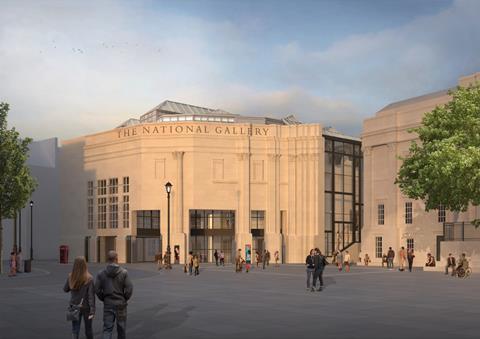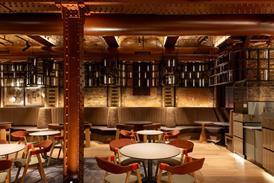Recommendation follows searing criticism from eight former RIBA presidents calling the revised scheme “even more ill-judged” than the former proposals

Selldorf’s revised plans to remodel the National Gallery’s grade I-listed Sainsbury wing are set to be given the green light next week despite eight former RIBA presidents calling the designs “even more ill-judged” than the previous proposals.
Westminster council’s planning officer has recommended the highly controversial application for approval at a meeting due to take place on 29 November.
It will see major alterations to the 1991 Venturi Scott Brown & Associates-designed building in order to increase visitor capacity, including removing a large section of floorplate, cladding pillars in sandstone and relocating a group of Egyptian-style columns.
The officer’s report admitted the plans would cause harm to the heritage of the building but concluded that this would be outweighed by “significant and weighty” public benefits.
These included the creation of a more welcoming environment for visitors through increased space and natural light, easier operation for security services and improved energy performance.
But the former RIBA presidents said the plans looked as if Selldorf “is trying to jam a modern building into the guts of the Sainsbury Wing and wholly change its character”.
Paul Hyett, Sunand Prasad, Ruth Reed, Angela Brady, Stephen Hodder, Jane Duncan, Ben Derbyshire, and Alan Jones said in a letter to the council that the plans would change a “finely conceived space into an airport lounge”.
The building, the only UK work by Venturi Scott Brown (VSBA), is widely considered to be among Britain’s most important public buildings of the second half of the 20th century.
It is known for its dark ground floor lobby, which leads via a grand staircase to a series of much brighter top-lit galleries on the first floor.
“The proposals wholly undermine the thoughtful sequence of spaces that [VSBA] introduced to prepare the visitor carefully and propitiously for the delights of the galleries above,” the former RIBA presidents said.
They concluded that the revised plans “on a cursory glance appears perhaps even more ill-judged” than the former proposals.

Historic England have taken a different view and appear to have shifted their position on the scheme in light of the revisions, having said in a consultation on the former version of the proposals that they would harm the building’s heritage.
In a second consultation, the organisation welcomed the alterations, which it said introduced “greater texture and soliditiy”, and conceded that the larger interventions, including the removal of part of the floor plate, were “necessary to accommodate large numbers of visitors and to provide more inclusive access”.
The group concluded that while the plans would still harm the building’s heritage, this would now be “no more than is necessary to secure the objectives that have been identified by the gallery as being key to the project”.
The Victorian Society and the Twentieth Century Society maintained their objections, with the latter saying a majority of the design choices previously objected to and which would cause “substantial and unjustifiable” harm were still part of the proposals.
Selldorf revised the plans last month after talks with original VSBA architect Denise Scott Brown.
The scheme was commissioned to mark the National Gallery’s bicentenary in 2024, and aims to make the Sainsbury Wing more able to function as the main entrance, a purpose for which it was never originally intended but which it has assumed following the adoption of a one way system.
Letter to Westminster council from eight former RIBA presidents in full
Dear Sirs
It is with great regret that we eight past presidents of the Royal Institute of British Architects, feel the need to object to and comment negatively upon the proposed alterations to the National Gallery’s Grade I Listed Sainsbury Wing. We have read the objections raised by Historic England, Historic Buildings and Places, and the Twentieth Century Society with whom we are significantly in accord.
This, the only UK work of the exceptional and ground-breaking Philadelphia-based architects Denise Scott Brown and Robert Venturi, was designed after intense research with passion, empathy, creativity, and delicacy. I and so many, many others love this wing which is the subject of current full planning and listed building applications due to be determined this autumn.
The National Gallery has advised that this Wing has become de facto the main entrance, as a result of a one-way system that they have introduced and no entry being possible via the original main entrance in the Wilkins Building. Surely Ed Jones’ masterplan from some years back to upgrade the main, central entrance should be re-visited? None of the changes proposed provide any additional visitor floorspace (indeed there are quite large areas removed) nor will the proposals cater for more visitors.
Selldorf Architects (NY) were, we believe, selected by competition to adapt the wing, but their proposed changes are to our minds insensitive and inappropriately changes a finely conceived space into an airport lounge. Their plans involve making drastic and irreversible changes. They have applied to gut the ground and first (mezzanine) floor to provide an espresso bar and cafeteria which will irreversibly alter the character of the building.
A beautifully designed sequence of spaces and the imaginative detailing, such as in the entrance floor with its huge columns and coffered ceiling, were inspired; it would be prudent to restore this space as originally constructed, with the colour scheme proposed by Venturi Scott Brown. Many great architects have emphasised the intense experience of moving from dark into light spaces, which was so very carefully considered.
It feels as if the architect is trying to jam a modern building into the guts of the Sainsbury Wing and wholly change its character - the VSBA ambience will be lost, and the ground and mezzanine floors detached psychologically from the main gallery floor.
Apart from the worrying precedent being set for Grade I Listed buildings elsewhere, the proposals wholly undermine the thoughtful sequence of spaces that Bob and Denise introduced to prepare the visitor carefully and propitiously for the delights of the galleries above.
We feel as many others do, that this project is ill-judged and that the Sainsbury Wing should be afforded more care and attention. The RIBA itself cannot of course comment, but as past presidents we feel it is imperative, in the face of such harmful proposals, that we make our views known as advocates for and defenders of appropriate, beautiful and considered architectural design.
We have noted that a revised scheme has been submitted, which on a cursory glance appears perhaps even more ill-judged. We will add further comments on this revised scheme if we consider it necessary in due course.
We would be pleased to offer you a meeting to discuss our views in more detail if this would prove useful.
Paul Hyett PPRIBA, Sunand Prasad PPRIBA, Ruth Reed PPRIBA, Angela Brady PPRIBA, Stephen Hodder PPRIBA, Jane Duncan PPRIBA, Ben Derbyshire PPRIBA, and Alan Jones PPRIBA.



















No comments yet